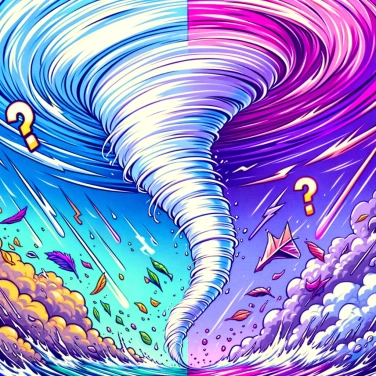In detail, for those interested!
Formation of tornadoes
Tornadoes generally form in environments where masses of warm and humid air collide with cold air. This phenomenon most commonly occurs during severe thunderstorms, where specific weather conditions promote the development of these destructive whirlwinds.
When a layer of warm and humid air is near the ground and cold air descends from a higher altitude, atmospheric instability can occur. This instability can lead to the formation of supercell storms, which are often associated with tornado formation.
In a supercell, winds can swirl around a central rotating core, forming what is known as a "mesocyclone". This mesocyclone is essential for tornado formation, as it creates the conditions for warm air to rise and produce a rotating column of air.
When this rotating column of air descends towards the ground, it can lead to tornado formation. Tornadoes are characterized by a violently swirling funnel in contact with the ground. Tornadoes can cause significant damage due to their violent winds and ability to lift and move heavy objects.
Tornado formation is a complex phenomenon that depends on many interacting atmospheric factors. Meteorologists continue to study these phenomena to better understand their development and improve early warning systems to protect populations in areas affected by these natural disasters.
Coriolis and the rotation movement of tornadoes
The rotation movement of tornadoes is influenced by a phenomenon called the Coriolis effect. The Coriolis effect is a fictitious force due to the rotation of the Earth. When a mass of air moves, the Coriolis effect deflects its trajectory to the right in the northern hemisphere and to the left in the southern hemisphere. This deflection is due to the difference in the Earth's rotation speed depending on the latitude.
In the case of tornadoes, the Coriolis effect can influence the rotation of the upward column of air that forms the tornado. As a result, tornadoes tend to rotate clockwise in the northern hemisphere and counterclockwise in the southern hemisphere. However, the Coriolis effect is not the only determining factor in the rotation of tornadoes; other local parameters can also play an important role.
Influence of local factors on the direction of rotation of tornadoes.
Local characteristics such as relief, topography, and the presence of obstacles can influence the direction of rotation of tornadoes. When a tornado forms near a mountain range or other significant obstacles, they can disrupt the vertical movement of air and result in variations in the direction of rotation of the tornado. Additionally, the friction created by air rubbing against the ground can also play a role in determining the direction of rotation of a tornado. Generally, tornadoes that form in the northern hemisphere tend to rotate clockwise due to the Coriolis effect, but local factors can sometimes counteract this effect and lead to variations in the observed direction of rotation.
![Explain why some countries change time zones?]()
![Explain why Alexander the Great refused to wear shoes.]()
![Explain why Alexander the Great always wore an impressive helmet.]()
![Explain why the last Chinese emperor was so young when he came to power?]()





















